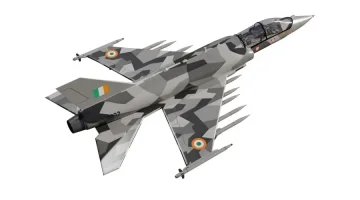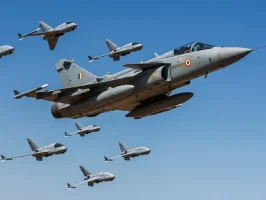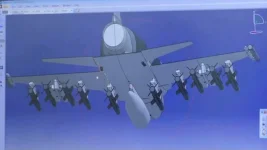- Views: 2K
- Replies: 12
Hindustan Aeronautics Limited (HAL), India's state-owned aerospace and defence company, has unveiled a concept for a new supersonic trainer aircraft, the Hindustan Lead-in Fighter Trainer (HLFT-42). This proposed aircraft draws design inspiration from the HAL HF-24 Marut, India's first indigenously developed jet fighter which first flew in the 1960s.
While HAL intends the HLFT-42 to honour India's aviation heritage and meet the Indian Air Force's (IAF) requirement for modern training jets, some aerospace experts are questioning the relevance of this retro-inspired approach in today's rapidly advancing global military aviation sector.
Critics suggest that instead of developing an aircraft based on older design principles, HAL could better serve India's needs and capture a unique international market position by creating an advanced single-engine stealth Lead-in Fighter Trainer (LIFT).
They advocate for a new design that incorporates cutting-edge technologies currently under development for India's flagship aerospace projects, the Advanced Medium Combat Aircraft (AMCA) and the Tejas Mk2.
Such an aircraft, experts argue, could fulfil domestic training requirements while also offering a unique, cost-effective stealth fighter option on the global export market, a category currently unaddressed by manufacturers worldwide.
HAL's proposed HLFT-42 concept is based on the delta-wing design of the historic Marut. It is envisioned as a supersonic LIFT intended to replace the IAF's current fleet of intermediate jet trainers, including the BAE Systems Hawk Mk132 and the older HAL HJT-16 Kiran.
HAL plans to equip the HLFT-42 with modern systems such as contemporary avionics and fly-by-wire flight controls, targeting a top speed above Mach 1.2. The company positions the HLFT-42 as a crucial training platform to prepare pilots transitioning from basic trainers to high-performance combat jets like the indigenous Tejas LCA and the Dassault Rafale.
Despite the patriotic sentiment associated with reviving the Marut's legacy, analysts express concern that the HLFT-42 concept might be out of step with current military aircraft design trends. They caution that the proposed aircraft could face stiff competition from well-established LIFT platforms already successful in the international market.
Competitors include South Korea's KAI T-50 Golden Eagle and its FA-50 light combat variant, Italy's Leonardo M-346 Master, and Russia's Yakovlev Yak-130, all of which boast proven capabilities and have achieved export sales.
Instead of refining a legacy design, experts propose that HAL should focus on pioneering a new aircraft class: a single-engine LIFT incorporating stealth characteristics and combat capabilities. This approach would leverage India's significant investments and progress in stealth technologies and advanced avionics for the AMCA and Tejas Mk2 programs.
Currently, no global aerospace company is actively developing a stealth LIFT. Even advanced trainers like the Boeing-Saab T-7 Red Hawk, developed for the US Air Force, are primarily focused on training roles with limited inherent combat potential.
A stealth-capable LIFT from HAL could fill this strategic gap, offering a versatile dual-role aircraft attractive to air forces seeking affordable platforms that serve as both trainers and light combat jets.
Experts highlight that choosing a single-engine design would offer considerable cost savings throughout the aircraft's lifecycle, from development and production to operation and maintenance, compared to twin-engine alternatives.
The General Electric F414 engine, already selected for the Tejas Mk2 and considered for the AMCA program, represents a mature, reliable, and readily available powerplant option. Its selection would ensure adequate performance for a LIFT while maintaining manageable operational costs, making a single-engine stealth trainer appealing to nations with budget constraints.
The global market for LIFT aircraft, while competitive, currently lacks an option that combines stealth features with significant combat utility. Existing platforms like the T-7 Red Hawk emphasize training efficiency but lack low-observable characteristics and are not primarily designed for weapon delivery.
Conversely, capable light combat aircraft like the FA-50 lack stealth features, increasing their vulnerability in modern high-threat environments. A HAL-developed stealth LIFT could carve out a unique market niche, attracting interest from:
- Air forces acquiring fifth-generation stealth fighters (like the F-35 or potentially the Su-75) who need trainers to acclimatise pilots to low-observable operations and advanced sensor fusion.
- Smaller air forces, particularly in regions like Southeast Asia, Africa, or Latin America, seeking versatile aircraft capable of performing training, light attack, border patrol, or counter-insurgency missions within limited budgets.
- India's strategic partners and allies, potentially through collaborative production arrangements under the "Make in India" initiative, expanding India's defence export portfolio.
Potential armament could include precision-guided bombs, anti-ship missiles, and air-to-air missiles like India's indigenous Astra missile, making it a credible light combat asset. Its stealth design would confer a significant survivability advantage, allowing it to undertake reconnaissance or strike missions in defended airspace with reduced risk.
For the Indian Air Force, such a stealth LIFT would provide an optimal training platform bridging the gap between basic turboprop trainers like the Pilatus PC-7 MkII and advanced combat aircraft such as the Su-30MKI, Rafale, Tejas, and the future AMCA.
It would be instrumental in training pilots in stealth tactics, managing advanced sensors, and operating within networked warfare environments – skills essential for operating fifth-generation aircraft.
Furthermore, its inherent combat capability could allow the IAF to utilize it for secondary missions like close air support or armed reconnaissance, thus preserving high-value frontline fighters for more demanding tasks.



